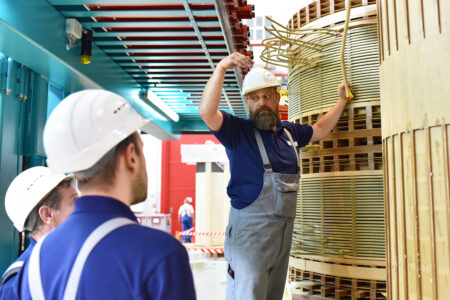What Are the Components of the Transformer Assembly?
Filed under: Uncategorized
Comments: None
 Transformers play a crucial role in the efficient transmission and distribution of energy. These devices act as the backbone of power grids, stepping voltages up or down to meet various requirements. Understanding the parts that make up a transformer assembly is vital to understand the inner workings and overall functionality.
Transformers play a crucial role in the efficient transmission and distribution of energy. These devices act as the backbone of power grids, stepping voltages up or down to meet various requirements. Understanding the parts that make up a transformer assembly is vital to understand the inner workings and overall functionality.
Electrical transformers are static devices that transfer electrical energy between circuits through electromagnetic induction. They consist of two coils of wire, known as primary and secondary windings, wrapped around a magnetic core. The primary winding is connected to the input voltage source, while the secondary winding is connected to the load. Its performance depends on proper installation and regular transformer maintenance services. It is critical to ensure that a team of skilled and experienced technicians can set up and maintain the equipment to keep it running efficiently.
Types of Transformers
Transformers are categorized into various types based on their applications and construction. The two primary classifications are:
Power Transformers: These are used in power generation stations, substations, and distribution networks. They handle high voltage levels, typically above 33 kV, and step down the voltage for consumer use.
Distribution Transformers: Distribution transformers are responsible for further voltage reduction, reducing it to safe levels for household and commercial applications. They are commonly seen on utility poles or in underground vaults, providing power to residential and industrial areas.
Components of the Transformer Assembly
Core: The core is the central part of a transformer that serves as a magnetic circuit. It is typically constructed from laminated steel sheets to minimize eddy current losses and maximize magnetic flux.
Windings: The primary and secondary windings are coils of wire wound around the transformer’s core. The primary winding connects to the input voltage source, while the secondary winding connects to the load. These windings are typically made of copper or aluminum and are insulated to prevent short circuits.
Insulation: Transformers use insulation to prevent electrical breakdowns. Materials such as varnishes, papers, and tapes are used to insulate the windings and the core.
Tap Changer: A tap changer allows the turn ratio of the transformer to be adjusted. It allows voltage regulation to compensate for fluctuations in the input voltage or load variations.
Cooling System: Transformers generate heat during operation. Cooling methods include air cooling, oil cooling, or a combination of both.
Bushings: Bushings provide a means to connect the transformer windings to the external electrical system. They serve as insulated interfaces, allowing power cables to be connected to the transformer without compromising its electrical integrity.
Protective Devices: Transformers use protective devices such as fuses, circuit breakers, and temperature monitoring systems to safeguard the unit against faults, overloads, and excessive temperatures.
Transformer Maintenance and Repair Services
Our team of technicians at North Central Electric specializes in a comprehensive range of repair and maintenance services. From routine maintenance tasks to complex electrical construction projects, we have the necessary skills and expertise to handle any job.
- Oil Processing
- Degasification
- Dehydration
- Fuller’s Earth
- Regasket
- LTC Inspection, Maintenance, and Repairs/Replacement
- Accessory Installation/Replacement
- Bushing Replacements
- Transformer Disposal
- Oil Diagnostics and Analysis
Transformers are vital devices for electrical power transmission and distribution. They facilitate the efficient transfer of electrical energy while maintaining voltage levels suitable for various applications. Understanding the components of a transformer assembly, such as the core, windings, insulation, tap changer, cooling system, bushings, and protective devices, helps us grasp the inner workings of these complex yet essential devices. With ongoing advancements in power technology, transformers continue to play a pivotal role in electrical construction and deliver reliable electricity to homes, businesses, and industries worldwide.
